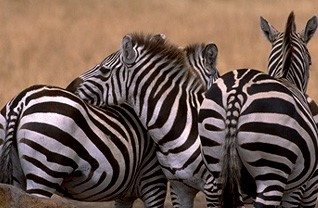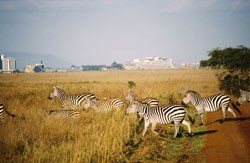Equus burchelli (Plains Zebra) -BIO203
Life History/Form&Function
The Equus burchelli has adapted very well to its environment to
survive on the plains of Africa. These adaptions include: stripes, good
defense structures and a robust digestive system. All these things make
it a very interesting animal that has adapted its form and fu nction
perfectly.
nction
perfectly.
The first thing that you need to know about zebras is that they are a
very distinct plains mammal, mainly for their black and white stripes.
The Equus burchelli, commonly known as the plains zebra is no different
from this, but their form is a little different. According to Jonathon
Bard the plains zebra have a dorsal stripe and the hind quarters have
shadowy stripes between some broad caudal stripes. He also explains that
the stripes are distinct to that animal almost like a fingerprint. This
is because in the embryo there are different concentrations of
melanocytes in the zebras cells (Bard 1981). It is not completely known
why zebras have stripes but a recent study by Adam Egri suggests that
these stripes have been known to decrease the number of
 bites
on the skin by horseflies (Egri et.al. 2012). Egri also said decrease in
bites positively impacts the fitness of the zebra and protects it from
the fly. This may not be the only reason that zebras have these stripes
other theories of why zebras have stripes are the following: stripes
make zebras look bigger, moving stripes dazzle predators, stripes blend
in with tall grass, thermoregulation. Click
here to see
the difference in stripes between the plains and Grevy’s Zebra. This is
not the only defense mechanism that helps the Equus burchelli.
bites
on the skin by horseflies (Egri et.al. 2012). Egri also said decrease in
bites positively impacts the fitness of the zebra and protects it from
the fly. This may not be the only reason that zebras have these stripes
other theories of why zebras have stripes are the following: stripes
make zebras look bigger, moving stripes dazzle predators, stripes blend
in with tall grass, thermoregulation. Click
here to see
the difference in stripes between the plains and Grevy’s Zebra. This is
not the only defense mechanism that helps the Equus burchelli.
The plains zebra also have great eyes and eye
placement. Where the eye is situated on the head of the zebra is crucial
to its survival (Ruxton 2002). It makes a much larger field of view to
look for predators in their surroundings while we have very limited
field of view they can see very far to the right and left. This is
imperative to survival because of animals like lions stalking abilities
the zebra need to always be vigilant. Another mechanism for survival is
the families that plains zebra form for protection. A normal group is
one male and a harem of females with their offspring (Rubenstein 1986).
This makes protecting against and detecting predators easier, the more
eyes looking out for hyenas and lions the better. These small groups are
known to join similar groups making large herds of plains zebra. There
are also details about the individual Equus bruchelli that make it a
formidable foe to take down. They are a fairly large animal with
dimensions of four and half feet tall and range in weight between 500
and 900 pounds (Wilsdon 2009). Plains zebras are also very fast with top
speeds of around 40 miles per hour this is sometimes needed for the wide
variety of predators they co me
up against. The muscular makeup of the plains zebra is imperative to
running at high speeds and delivering very hard kicks to predators.
Instead of having their leg muscles exclusively on their legs they have
all their muscle in the rump an shoulder section (Canvendish 2010). But
there is more to zebras than just defense.
me
up against. The muscular makeup of the plains zebra is imperative to
running at high speeds and delivering very hard kicks to predators.
Instead of having their leg muscles exclusively on their legs they have
all their muscle in the rump an shoulder section (Canvendish 2010). But
there is more to zebras than just defense.
Zebras are
grazers and this means that they are herbivores. They need to eat such
large quantities that they are eating for almost twenty hours a day.
With all of this eating of mostly poor quality savannah grasses they
need a very good digestive tract (Owaga 1975). Unlike most ruminants
they utilize a hind-gut digestive tract, which processes food at faster
rates than other plains animals (Hack & Rubenstein 2002). The plains
zebra also needs to drink water only once a day and can survive well
with little water. When nursing young most females need more water and
will not be able to go too far from water with her foal. This way of
ingestion is perfect for animals that may have to survive very harsh
conditions.